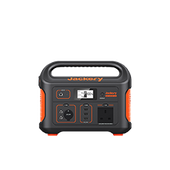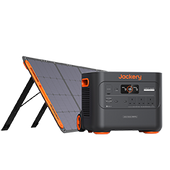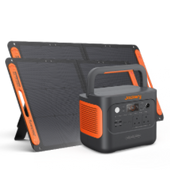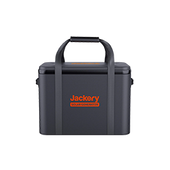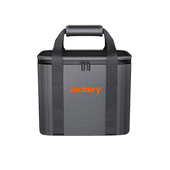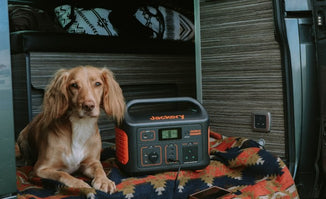A sudden power interruption can be your worst nightmare because it disrupts your daily routine. We live in an era where we cannot fathom life without electricity. However, power outages are common during natural disasters and other circumstances. In such a scenario, having your emergency electricity source is the most effective defense.
Electricity is the backbone of contemporary industrial society. HVAC, lighting, ventilation, communications, life support systems, and computation rely on electricity.
The power could go out for a variety of reasons at any time. This page explains everything about emergency electricity sources, including what they are, their advantages, types, and how to select one. In addition, we recommend Jackery Solar Generators with expandable capacities so you no longer have to worry about your residence or business running out of power.
|
Products |
Images |
Capacity |
Rated / Peak Power |
Battery |
Size |
|
Solar Generator 2000 Plus |
|
2-12 kWh |
3000W Rated, 6000W Peak |
LiFePO4 |
14.7x18.6x14.1in |
|
Solar Generator 1000 Plus |
 |
1.25-2.5kWh |
2000W Rated, 4000W Peak |
LiFePO4 |
14x10.24x11.14in |
What Is Emergency Electricity Source?
An emergency electricity source is an alternative source of electrical power. It is typically used to power essential electrical and electronic devices during power outages. Solar energy is the finest option for emergency power generators, for instance.
It is a renewable, accessible, and non-polluting source of energy. However, only some residences can benefit from solar energy. This situation necessitates the use of gas generators or emergency battery backup power. Let's examine both of these in depth in the following section.
An emergency power source typically comprises a generator, batteries, and other equipment. If the principal electric power supply fails, emergency power systems are installed to safeguard life and property. It is a form of uninterrupted power supply.
What Are The Benefits of Emergency Electricity Source?
Traditionally, generators propelled by gasoline, propane, diesel fuel, and renewable energy provide emergency electricity. Investing in one will provide your household or business with a means to generate electricity during a power outage. The advantages of using an emergency power supply are as follows:
Reduce Business Interruptions: There's an imminent financial risk to businesses in a power outage. Production ceases, manufacturing ceases, and consumers are unable to receive services. Employees cannot operate their equipment without a reliable emergency electricity source, and managers and administrative staff cannot access digital resources.
Minimize Risks: In many instances, power disruptions can increase the likelihood of workplace injury. The abrupt loss of power in a warehouse can create visual safety hazards that employees must negotiate. Power disruptions caused by storms or other weather-related disasters pose immediate risks to worker safety in outdoor settings. However, reducing the risk of injury is simple if you own an emergency electricity source.
Lower Equipment Damage: Power interruptions can cause equipment damage. Hard drives can be damaged when power is abruptly restored, and computer circuit boards can become overwhelmed. Equipment fuelled by electricity is designed for specific voltages. When the power goes out and is abruptly restored, a temporary power surge can occur, resulting in an increase in voltage that overloads your equipment. In contrast, if you have a backup power source, you will never have to worry about equipment or devices failing due to a power outage.
What Are The Types of Emergency Electricity Sources?
Access to multiple power sources enables you to manage a variety of emergencies. Due to the unpredictability of the future, it is prudent to maintain multiple short-term power sources, such as rechargeable batteries, and at least one more significant power source, such as an emergency generator.
Being prepared and understanding how to operate a backup power source makes all the difference during a power disruption. There are short-term and long-term emergency electricity sources; continue reading to learn more about them!
Short-Term Emergency Electricity Sources
A short-term power outage occurs when a household loses electricity for one to several days. Even though these power outages are not particularly hazardous in mild weather, you should still be prepared. Since predicting how long a blackout will last is impossible, it is best to anticipate the worst and pray for the best.

Various short-term emergency electricity sources are available to get you through a blackout. It is simply a matter of determining what you and your family will utilize the most.
Ensure that your power sources are portable and simple to operate when selecting them. If you need to evacuate, you'll need a method to keep your phone charged and operational; it's the quickest way to call for help.
Rechargeable Batteries
Homes have utilized rechargeable batteries and devices for years. They provide both reusable resources and capability that is simple to use. They're one of the most reliable power sources you can acquire, regardless of whether they're purchased for everyday use or only for emergencies.
Numerous emergency devices, including flashlights, phones, and radios, can be powered by rechargeable batteries. They are simple to operate and cost-effective in the long run. Overall, rechargeable batteries are healthier for the environment.
|
Rechargeable Batteries Pros: |
Rechargeable Batteries Cons: |
|
- Easy to use - Environmental-friendly - Affordable |
- Lower voltage ratings and capacities - Up-front costs - Lower lifespan - Lower quality |
Portable Power Bank
A portable power bank is an emergency kit's most useful electronic device. Portable power banks are pocket-sized devices that can charge various electronic devices.
These power banks can charge cell phones, tablets, and other small electronics. Many portable power banks are so compact that they can fit anywhere, such as in a pocket, handbag, or survival kit.
Having at least one power bank is the best method to guarantee constant power. However, portable power banks have lesser capacities, which are insufficient for home appliances and only sufficient for personal electronics such as your phone, radio, and headphones. In addition, you must recharge the power batteries using grid electricity, which is unsuitable for unexpected power outages.
|
Portable Power Bank Pros: |
Portable Power Bank Cons: |
|
- Portability - Easy to carry - Convenient |
- Need grid to recharge - Easy to break - Lower capacity - Only can power one or two devices |
Gas Generator
In specific communities, gas-powered generators are ubiquitous. Numerous households and enterprises have an emergency kit. Gas-powered generators are a fantastic choice due to their dependability and ease of operation in situations ranging from severe cyclones to everyday power outages. If you frequently need shelter in place, you must keep a gas-powered generator outside your residence.
In contrast to portable power banks, which can only power one or two lights, gas generators can power various survival appliances as short-term emergency electricity sources, including your bilge pump, refrigerator, and furnace fan.
However, you must purchase and store petroleum in advance to use gas generators in an emergency, which incurs additional expenses. The natural gas supply can be interrupted during calamities such as earthquakes. In addition, natural gas is not a clean and renewable energy source on Earth.
|
Gas Generator Pros: |
Gas Generator Cons: |
|
- Powerful - Reliability - Easy to use |
- Non-renewable energy - Higher costs - Higher use risks - Need gasoline - Need maintenance |
Solar Generator
Life stops when the power goes out; it's not just inconvenient. Food is immediately at risk of spoiling, electronic devices cannot be charged, and appliances and medical equipment become ineffective. You are in dire straits. A complete solar-powered generator kit will safeguard you against this danger.
The popularity of solar generators for emergency preparedness is attributable to their portability and "plug-and-play" capabilities. Place your solar generator close to your living quarters so you can plug everything in, then connect your solar panels and position them in the sun.
In a real-world catastrophe scenario, the ability to locate and acquire fuel could be hazardous. Therefore, the ability to operate your solar generator without gasoline is not only a significant advantage but could also determine whether you have power.
Solar generators offer more advantages than the other emergency electricity sources outlined above, including portability, ease of use, sustainability, versatility, and no maintenance requirements. Jackery Solar Generators, a combination of Jackery Solar Panels and Portable Power Stations, are an emergency power source that can be utilized during a power outage. You only need to place it under the sun, generating electricity effortlessly and effectively.
|
Solar Generator Pros: |
Solar Generator Cons: |
|
- Reliability - Easy to use - Easy to carry - Versatility - Renewable energy - No need maintenance |
- Some high-capacity solar generators are costly but cost-effective in the long term. |
Long-Term Emergency Electricity Sources
After prolonged power outages, you may question if your power will ever be restored, and you may wish you had emergency electricity sources that could provide long-term power. You recognize you cannot run for an extended period with only a few small power banks and rechargeable batteries. Whether or not you live off the grid, it is prudent to have a method to generate your power.

Whole House Solar Generator
To mitigate the terrifying effects of a power outage, homeowners can install a solar generator for their entire residence. These devices enable your home to maintain power for days during a blackout. These generators' batteries are powerful enough to power a house, including all large appliances, electronic devices, and heating and conditioning systems. Additionally, you can connect multiple generators and batteries to increase capacity.
A whole-house solar generator kit is an excellent method to achieve energy independence so that you are not subject to power outages and an aging grid infrastructure. There are numerous options available to meet the electricity requirements of various households. For example, Jackery Solar Generator 2000 Plus has 2 to 12 kWh expandable capacity to ensure you have enough electricity for an extended period in an emergency.
Gas and diesel generators are notorious for their extremely loud operation. A whole-house solar generator is practically silent due to the lack of moving elements. Adding PV solar panels to a whole-house solar generator allows you to power your home without worrying about gas prices or utility companies.
|
Whole House Solar Generator Pros: |
Whole House Solar Generator Cons: |
|
- Sustainability - Expandable batteries - Multiple recharge methods - Easy to use - SMART App control - Lower noise level |
- Some whole-house solar generator is pricey but is cost-effective in the long term. |
Windmill
Windmills have been used to generate electricity since the 9th century, and this practice has evolved. Windmills are one of the most effective methods to generate wind power and are a fantastic option for living off the grid.
The average UK household consumes approximately 830 kWh of electricity per month, so you'll need to be prepared to generate a considerable amount of electricity - which is quite feasible.
Before you install windmills, however, you should consult with your local weather service to determine the average wind speed in your area. You must reside where the average annual wind speed is 14 mph.
|
Windmill Pros: |
Windmill Cons: |
|
- Renewable energy - Lower operating costs - Good for the environment |
- Need professional installation - Need maintenance - Higher costs - Need a lot of wind yearly - Noisy - Potential danger |
How Many Watts Does A House Use in An Emergency?
Consider all factors when deciding on the emergency electricity sources for your home and emergency bag. What will require the most electricity in your home? Do you possess any medications that require refrigeration? Perhaps an infant who needs a night light to feel secure?
During a power outage, some households may require more energy consumption and appliances, while others may only need a few. A generator producing between 4,000 and 8,000 watts would be sufficient to power a typical residence.
The watt is the fundamental unit of power measurement, and emergency power sources have two essential wattage ratings: rated wattage and surge wattage. As you would anticipate, a standard 60-watt incandescent light bulb requires 60 watts when turned on and operating.
|
Home Appliances |
Rated Wattage |
Surge Wattage |
|
Light Bulb |
60W |
60W |
|
TV |
300W |
400W |
|
Fan |
80W |
150W |
|
Home Monitor |
400W |
600W |
|
Oven |
700W |
1500W |
|
Electric Blanket |
400W |
400W |
|
Refrigerator |
1000W |
2000W |
|
Water Pump |
2000W |
3200W |
Jackery Solar Generators for Emergencies
Jackery is the industry leader in producing portable power stations, solar panels, and portable solar generators. To protect the environment, we always contemplate sustainability and utilize solar energy as our power source.

Jackery Solar Generators combine Jackery Solar Panels and Portable Power Stations to convert sunlight into electricity, which can then be used to power domestic appliances, such as a refrigerator, CPAP machine, water pump, and more, during a power outage.
These portable generators include Jackery Solar Generators, which are lightweight and compact. Choose between 240Wh and 12kWh, depending on your home's energy requirements.
Before purchasing a solar generator, it is prudent to determine the amount of electricity required for emergency purposes. This formula can calculate the Jackery Solar Generator's operational lifetime.
Working Time = Power Station Capacity*0.85 / Your Device's Operating Wattage
Jackery Solar Generator 2000 Plus
The Solar Generator 2000 Plus has a massive capacity that can be expanded from 2 kWh to 12 kWh. Add a battery pack and solar panels for an additional 12 kWh of electricity. It is excellent for home emergency power backup or off-grid living. Power is now completely self-sufficient, taking only two hours to charge with solar energy fully.

A single Jackery Explorer 2000 Plus Power Station can support up to five additional battery packs simultaneously, increasing capacity from 2 kWh to an impressive 12 kWh - perfect for short-term power outages and home emergencies. Two paralleled Jackery Explorer 2000 Plus portable power stations produce 12 kWh, ideal for long-term power interruptions.
The Solar Generator 2000 Plus can be fully charged in two hours thanks to 6* SolarSaga 200W solar panels. The power source becomes entirely self-sufficient by replacing the power grid with solar energy. Alternatively, the power station can be recharged with an AC converter or a 12V carport. Multiple output ports enable the charging of numerous home appliances simultaneously.
|
|
Capacity |
Battery |
Output Ports |
Working Hours |
|
Solar Generator 2000 Plus |
2-12 kWh |
LiFePO4 |
3*AC Output: 120V~60Hz, 2000W, 4000W Peak; 2*USB-A: 18W Max, 5-5V⎓3A; 2*USB-C: 100W Max, (5V, 9V, 15V, 12V, 20V up to 5A); 1*Carport: 12V⎓10A |
Light(60W): 27.2H TV(300W): 5.4H Fan(80W): 20.4H Oven(700W): 2.3H Refrigerator(1000W): 1.6H Water Pump(2000W): 0.8H |
Jackery Solar Generator 1000 Plus
Because of its exceptional output, the Jackery Solar Generator 1000 Plus is the perfect home emergency electricity source. It also provides power for outdoor working, camping, RVing, off-grid living, and other activities. This solar generator, which is versatile and scalable in capacity, is an all-in-one option for powering your existence.

The 1000 Plus offers the highest production among comparable goods, supporting 99.9% of devices, with a capacity of 1264Wh and an output of 2000W. It may be expanded up to 5 kWh, which is enough electricity for a home emergency. It can, for example, run a 500W CPAP machine for 1.4 hours and a 60W light bulb for more than 16.9 hours.
Over its 10-year life cycle, the Jackery 1000 Plus's Lithium Iron Phosphate (LiFePO4) battery provides a consistent voltage and pure sine wave, ensuring the safety of all your electrical appliances. The revolutionary ChargeShield technology and constant power supply prevent equipment damage.
|
|
Capacity |
Battery |
Output Ports |
Working Hours |
|
Solar Generator 1000 Plus |
1.25-2.5 kWh |
LiFePO4 |
5*AC Output: 120V~ 60Hz, 20A Max, 120V~ 60Hz, 25A Max, 3000W Max, 6000W surge; 2*USB-A: Quick Charge 3.0, 18W Max; 2*USB-C: 100W Max, (5V, 12V, 9V, 15V, 20V up to 5A); 1*Carport: 12V⎓10A |
Light(60W): 16.9H TV(300W): 3.4H Fan(80W): 12.6H Oven(700W): 1.4H CPAP(500W): 2H Refrigerator(1000W): 1H |
How to Choose The Emergency Electricity Source?
Power outages can occur at any time, so you should be prepared. If you are looking for an emergency power source, look for the following features before purchasing.
Power Needs: Choosing the correct emergency supply is determined by various criteria, including the gadgets you want to use when you require electricity and your budget. Solar generators are the perfect option for home appliances and devices that require extra electricity, but the initial cost can be high.
Battery backup systems and portable units are ideal for smaller devices and have the added benefit of being environmentally friendly. During a power outage, a whole-house solar generator is perfect for powering vital devices such as computers and servers, such as the Jackery Solar Generator 2000 Plus, which has a capacity of 2 to 12 kWh and is sufficient for powering a household.
Using Frequency: The frequency you use a kit might help you identify which is ideal. Will your whole-house solar generator be used regularly or only in an emergency? If you only require the system for a brief power loss, the Jackery Solar Generators are ideal. The improved battery storage and output capabilities of the Jackery Solar Generator Plus series will benefit larger households with more occupants.
Battery Capacity: What will your kit be able to power? A larger battery capacity is required to do laundry and run other major appliances. A lesser system will suffice if you only need to keep the lights on.
Final Thoughts
Blackouts that last many hours are likely to disturb your regular activities. Instead of living in the dark in such a case, you should employ a dependable emergency power source. A solar generator can provide sufficient power to an entire household. Like a regular gas generator, a solar generator can be connected to a power inlet box to distribute electricity throughout the house. Flip the power transfer switch on your electrical panel to use the generator instead of the grid. We highly recommend Jackery Solar Generators for powering your home or business in an emergency.









